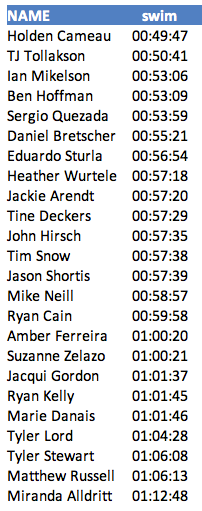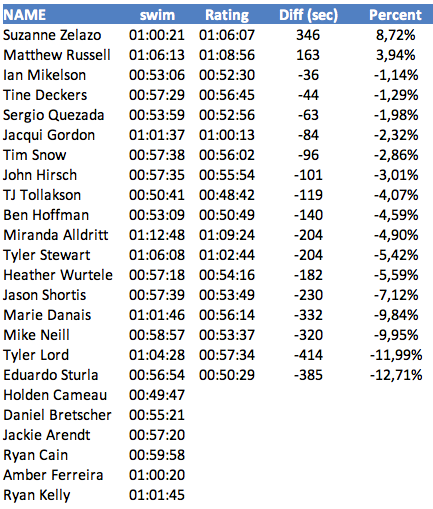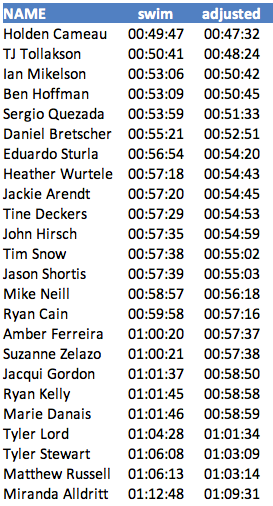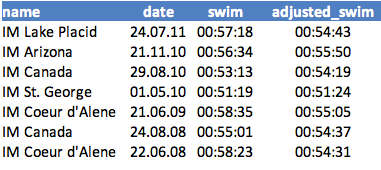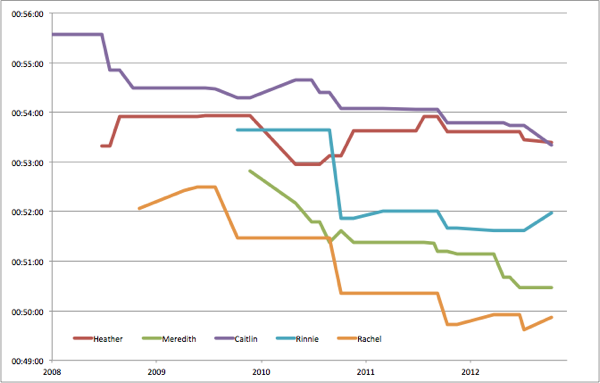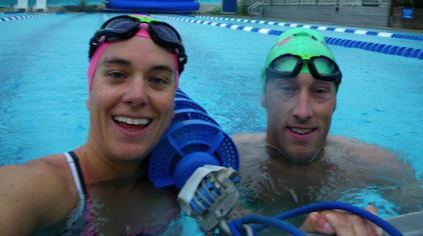IM Cozumel 2012 – Analyzing Results
Reports from Cozumel indicate that conditions were pretty hard (choppy swim, windy bike, hot run). This is backed up by the race adjustment, at 4:13 it was the slowest ever in Cozumel (new course rating of 8:18), it also lead to a number of good athletes either DNFing or finishing much slower than they usually do.
Male Race Results
After Nils Frommhold in Arizona, Ivan Rana was another Ironman rookie winning his debut race (and he also posted new overall and run course records):
| Rank | Name | Nation | Swim | Bike | Run | Actual Time | Expected Time |
| 1 | Ivan Rana | ESP | 00:50:27 | 04:37:16 | 02:44:05 | 08:15:07 | n/a |
| 2 | Bas Diederen | 00:50:17 | 04:37:39 | 02:51:57 | 08:22:55 | n/a | |
| 3 | Bert Jammaer | BEL | 00:52:08 | 04:36:04 | 02:53:18 | 08:24:51 | 08:47:12 |
| 4 | Anton Blokhin | UKR | 00:52:10 | 04:35:59 | 02:55:19 | 08:26:38 | 08:48:21 |
| 5 | Jimmy Johnsen | DNK | 00:52:30 | 04:37:37 | 02:56:00 | 08:29:09 | 08:40:43 |
| 6 | Brandon Marsh | USA | 00:50:08 | 04:37:55 | 02:59:07 | 08:30:17 | 08:55:09 |
| 7 | Michael Lovato | USA | 00:52:23 | 04:35:12 | 03:05:44 | 08:37:14 | 08:46:56 |
| (8) | James Cunnama | ZAF | 00:52:16 | 04:35:26 | 03:06:48 | 08:37:46 | (added from official results) |
| 8 | Stefan Schmid | GER | 00:57:48 | 04:40:19 | 02:58:09 | 08:41:09 | 08:52:09 |
| 9 | Andres Castillo Latorre | COL | 00:50:13 | 04:37:53 | 03:10:59 | 08:42:06 | 09:05:13 |
| 10 | Ezequiel Morales | ARG | 00:57:39 | 04:40:43 | 03:03:16 | 08:44:58 | 08:51:38 |
| 11 | Luke McKenzie | AUS | 00:50:19 | 04:35:12 | 03:16:58 | 08:45:57 | 08:39:49 |
| 12 | Andrey Lyatskiy | RUS | 00:52:19 | 04:52:34 | 08:48:04 | 08:48:04 | 08:59:00 |
| 13 | Eduardo Sturla | ARG | 00:57:33 | 04:46:01 | 03:05:24 | 08:52:42 | 08:38:51 |
| 14 | Alexander Grigoryev | RUS | 00:52:18 | 04:43:34 | 03:18:24 | 08:58:03 | 08:58:28 |
| 15 | Sylvain Rota | FRA | 00:52:36 | 04:35:03 | 03:27:32 | 08:58:45 | 08:48:49 |
| 16 | Thiago Vinhal | BRA | 00:52:05 | 05:07:56 | 02:59:14 | 09:04:10 | 09:02:00 |
| 17 | Olivier Cardoen | BEL | 00:58:49 | 04:46:16 | 03:18:35 | 09:07:48 | n/a |
| 18 | Ciro Violin | BRA | 00:56:54 | 04:52:20 | 03:20:20 | 09:13:45 | 08:55:36 |
| 19 | Rene Vallant | AUT | 00:57:38 | 04:40:47 | 03:34:40 | 09:17:27 | 09:24:21 |
| 20 | Patrick Jaberg | SWI | 00:57:29 | 04:58:01 | 03:25:12 | 09:25:09 | 08:51:02 |
| 21 | Jesse Vondracek | USA | 00:57:36 | 05:14:18 | 03:12:31 | 09:28:13 | 09:27:54 |
| 22 | Edo Van der Meer | NED | 00:50:15 | 04:38:10 | 03:57:59 | 09:29:36 | 09:01:14 |
| 23 | Patrick Evoe | USA | 00:58:00 | 04:38:02 | 04:03:03 | 09:42:47 | 08:46:35 |
| 24 | Mario Fink | AUT | 00:56:57 | 04:41:18 | 04:09:46 | 09:51:50 | 09:09:44 |
| 25 | Dirk Bockel | LUX | 00:50:15 | 04:28:39 | 04:30:21 | 09:52:18 | 08:19:01 |
| 26 | Hiroyuki Nishiuchi | JPN | 00:52:13 | 05:23:38 | 03:36:59 | 09:57:44 | 09:23:34 |
| 27 | Sergio Quezada | MEX | 00:52:16 | 05:07:10 | 03:56:45 | 10:01:25 | 09:59:24 |
| 28 | Reinaldo Oliveira | BRA | 01:08:32 | 05:14:16 | 03:38:30 | 10:05:53 | 10:24:56 |
| 29 | Bojan Maric | SCG | 01:07:20 | 05:15:27 | 03:43:02 | 10:11:19 | 10:08:34 |
| 30 | Tom Svoboda | CZE | 00:56:56 | 05:12:26 | 04:48:32 | 11:01:40 | n/a |
| 31 | Mauro Cavanha | BRA | 00:52:14 | 04:51:01 | 05:14:32 | 11:01:46 | n/a |
| 32 | Matjaz Kovac | SVN | 01:08:08 | 06:37:56 | 04:36:20 | 12:31:05 | 09:51:36 |
| 33 | Christopher Bagg | USA | 00:57:48 | 04:58:25 | 13:58:39 | 13:58:39 | 09:25:40 |
| 34 | Ivan Tejero Vazquez | ESP | 00:52:11 | 05:16:42 | 07:59:01 | 14:12:34 | 09:57:43 |
| 35 | Franz Höfer | AUT | 00:52:10 | 05:30:15 | 14:12:37 | 14:12:37 | 08:30:46 |
Update: Added James Cunnama. Note: There may be some changes – according to Twitter James Cunnama finished in 8th (but is shown as DNF on ironmanlive.com.)
Female Race Results
On the women’s side, Mary Beth Ellis (and also Sonja Tajsich and Michelle Vesterby) continued the trend of athletes using their on a fitness to validate their Kona entries. (Previous Kona winners such as Mirinda Carfrae and Leanda Cave just need to validate their slot, but usually the Kona Top 10 already have enough points to place properly and also basically just have to validate.) While their results may not be up to their usual standard (all of the mentioned athletes except Michelle raced slower than their rating would predict and there were some “explosions” on the men’s side such as Dirk Bockel), they secured their Kona slots and now have total flexibility to plan their next racing season.
| Rank | Name | Nation | Swim | Bike | Run | Actual Time | Expected Time |
| 1 | Mary Beth Ellis | USA | 00:54:36 | 05:05:26 | 03:11:17 | 09:15:38 | 09:10:25 |
| 2 | Sophie De Groote | BEL | 01:04:59 | 04:57:01 | 03:09:47 | 09:15:45 | 09:28:33 |
| 3 | Sonja Tajsich | GER | 01:13:55 | 05:00:15 | 03:02:40 | 09:21:30 | 09:17:52 |
| 4 | Michelle Vesterby | DNK | 00:54:34 | 05:02:17 | 03:22:26 | 09:23:49 | 09:27:47 |
| 5 | Kathleen Calkins | USA | 01:05:07 | 05:03:40 | 03:12:42 | 09:25:58 | 09:31:22 |
| 6 | Heidi Sessner | GER | 01:05:03 | 00:00:00 | 09:31:00 | 09:31:00 | 09:57:11 |
| 7 | Mareen Hufe | GER | 01:11:09 | 04:57:42 | 03:19:20 | 09:32:19 | 09:41:14 |
| 8 | Beth Walsh | USA | 01:11:14 | 05:21:18 | 03:02:39 | 09:39:25 | 09:41:53 |
| 9 | Elizabeth Lyles | USA | 01:07:09 | 05:17:24 | 03:12:04 | 09:40:36 | 09:24:57 |
| 10 | Jackie Arendt | USA | 01:04:57 | 05:14:41 | 03:19:38 | 09:44:05 | 09:53:03 |
| 11 | Anne Basso | FRA | 01:04:51 | 05:21:12 | 09:46:58 | 09:46:58 | 10:16:50 |
| 12 | Michaela Rudolf | AUT | 01:15:42 | 05:08:23 | 03:19:13 | 09:48:43 | 09:47:01 |
| 13 | Stephanie Jones | USA | 01:20:39 | 05:11:34 | 03:14:54 | 09:51:59 | 10:04:09 |
| 14 | Ayesha Rollinson | CAN | 01:03:33 | 05:15:48 | 03:28:22 | 09:53:26 | n/a |
| 15 | Jacqui Gordon | USA | 01:07:15 | 05:11:49 | 03:32:10 | 09:55:25 | 10:05:29 |
| 16 | April Lea Gellatly | USA | 01:03:38 | 05:16:01 | 03:33:10 | 09:57:59 | 10:22:38 |
| 17 | Paolina Allan | CAN | 01:13:50 | 05:13:56 | 03:28:20 | 10:00:21 | 10:01:13 |
| 18 | Tenille Hoogland | CAN | 00:54:27 | 05:06:47 | 03:56:19 | 10:02:22 | n/a |
| 19 | Marie Danais | CAN | 01:05:09 | 05:32:11 | 03:53:47 | 10:37:29 | 10:30:06 |
| 20 | Kristin Baker | CAN | 01:22:32 | 05:48:44 | 03:45:46 | 11:04:05 | 10:42:47 |
| 21 | Annett Kamenz | GER | 01:13:54 | 06:14:35 | 05:10:42 | 12:46:28 | 10:20:54 |
| 22 | Saki Kubota | JAP | 01:13:26 | 06:37:40 | 05:28:08 | 13:29:22 | 11:20:15 |
| 23 | Francesca Tibaldi | ITA | 01:15:37 | 00:00:00 | 14:09:24 | 14:09:24 | 10:04:15 |
